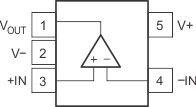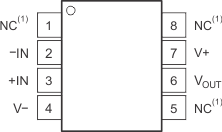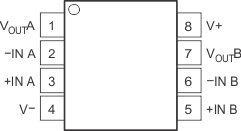SBOS365G may 2006 – may 2023 OPA2365 , OPA365
PRODUCTION DATA
- 1
- 1 Features
- 2 Applications
- 3 Description
- 4 Revision History
- 5 Device Comparison Table
- 6 Pin Configuration and Functions
- 7 Specifications
- 8 Detailed Description
- 9 Application and Implementation
- 10Device and Documentation Support
- 11Mechanical, Packaging, and Orderable Information
Package Options
Mechanical Data (Package|Pins)
- D|8
Thermal pad, mechanical data (Package|Pins)
Orderable Information
6 Pin Configuration and Functions
 Figure 6-1 OPA365: DBV Package, 5-Pin
SOT-23 (Top View)
Figure 6-1 OPA365: DBV Package, 5-Pin
SOT-23 (Top View)
(1) NC denotes no internal
connection.
Figure 6-2 OPA365: D Package, 8-Pin
SOIC (Top View)Pin Functions: OPA365
| PIN | TYPE | DESCRIPTION | ||
|---|---|---|---|---|
| NAME | SOIC | SOT | ||
| –IN | 2 | 4 | Input | Negative (inverting) input |
| +IN | 3 | 3 | Input | Positive (noninverting) input |
| NC | 1, 5, 8 | — | — | No internal connection (can be left floating) |
| V– | 4 | 2 | — | Negative (lowest) power supply |
| V+ | 7 | 5 | — | Positive (highest) power supply |
| VOUT | 6 | 1 | Output | Output |
 Figure 6-3 OPA2365: D Package, 8-Pin SOIC
(Top View)
Figure 6-3 OPA2365: D Package, 8-Pin SOIC
(Top View)Pin Functions: OPA2365
| PIN | TYPE | DESCRIPTION | |
|---|---|---|---|
| NAME | NO. | ||
| –IN A | 2 | Input | Negative (inverting) input signal, channel A |
| +IN A | 3 | Input | Positive (noninverting) input signal, channel A |
| –IN B | 6 | Input | Negative (inverting) input signal, channel B |
| +IN B | 5 | Input | Positive (noninverting) input signal, channel B |
| V– | 4 | — | Negative (lowest) power supply |
| V+ | 8 | — | Positive (highest) power supply |
| VOUTA | 1 | Output | Output, channel A |
| VOUTB | 7 | Output | Output, channel B |